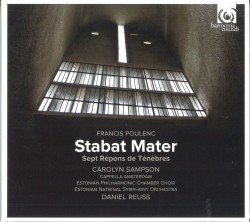 Poulenc – Stabat Mater; Sept Répons de Ténèbres
Poulenc – Stabat Mater; Sept Répons de Ténèbres
Carolyn Sampson; Cappella Amsterdam; Estonian National Symphony Orchestra; Daniel Reuss
Harmonia Mundi HMC 902149
In the 1930s Francis Poulenc started to display a more introspective character in his compositions. A period of soul-searching after the deaths of two close to him, his lover Raymonde Linossier and composer Pierre-Octave Ferroud, Poulenc began to explore the religion he had once set aside, undertaking a pilgrimage and adding sacred music to his oeuvre. Highly personalized, the subsequent works seem to vacillate between two sides of the composer’s life, embodying both sublime reverence and worldly excess. His settings of Stabat Mater and Sept Répons de Ténèbres were composed two decades later and represent the mature expression of this dichotomy, breaking character from the solemnity with expressions of extreme emotional, sensual and even dancelike diversions. This is a challenging drama for an ensemble to undertake, to tackle Poulenc’s personification of the sacred and express it in all its complexity. The flawless voicings of Capella Amsterdam and the Estonian Chamber Choir and superb musicianship of the Estonian National Symphony Orchestra led by Daniel Reuss produce a truly affective interweaving of these seemingly diverse elements while the dulcet renderings of soprano Carolyn Sampson perfectly embody the Marion essence.



